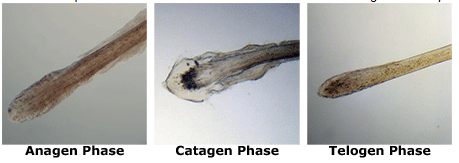Archival Notice
This is an archive page that is no longer being updated. It may contain outdated information and links may no longer function as originally intended.
Home | Glossary | Resources | Help | Contact Us | Course Map
Hair is an appendage of mammalian skin. It grows outwards from its root, which lies below the surface of the skin and is housed within a hair follicle. The root is surrounded by an inner root sheath and an outer root sheath. The hair shaft that protrudes above the skin surface is made of a strong structural protein called keratin; the same protein that makes up the nails and the outer layer of skin.
Hair follicles grow in repeated cycles, termed the anagen, catagen, and telogen phases. Most hairs are in the anagen or growth phase, during which they have a full-sized and active follicle.
At the end of the anagen phase, hairs enter into the transition, or catagen, phase. The hair follicle shrinks, and metabolic activity and hair growth begins to slow down. The hair then enters the resting, or telogen phase. Metabolism and growth cease. The follicle eventually reenters the anagen phase, and a new hair grows, pushing out the old, dead, one.
Although there is some evidence that the hair shaft can contain ABO substances, identification of origin of a hair by the techniques available to traditional serology depends on the shed hair having root material attached. In these cases, ABO and enzyme typing can produce good results.
Today, nuclear and mitochondrial DNA typing allow excellent assignment of origin of hairs even when there is no root material. There is some controversy about nuclear DNA typing of shafts. It may be that results depend on the presence of adsorbed material from sweat or other body fluids, therefore thorough washing is critical. Mitochondrial DNA typing is generally reliable but is, at present, a lengthy and costly procedure. It is best conducted on hairs that have been screened using conventional microscopy and found not to be distinguishable from the target source.
Additional Online Courses
- What Every First Responding Officer Should Know About DNA Evidence
- Collecting DNA Evidence at Property Crime Scenes
- DNA – A Prosecutor’s Practice Notebook
- Crime Scene and DNA Basics
- Laboratory Safety Programs
- DNA Amplification
- Population Genetics and Statistics
- Non-STR DNA Markers: SNPs, Y-STRs, LCN and mtDNA
- Firearms Examiner Training
- Forensic DNA Education for Law Enforcement Decisionmakers
- What Every Investigator and Evidence Technician Should Know About DNA Evidence
- Principles of Forensic DNA for Officers of the Court
- Law 101: Legal Guide for the Forensic Expert
- Laboratory Orientation and Testing of Body Fluids and Tissues
- DNA Extraction and Quantitation
- STR Data Analysis and Interpretation
- Communication Skills, Report Writing, and Courtroom Testimony
- Español for Law Enforcement
- Amplified DNA Product Separation for Forensic Analysts


